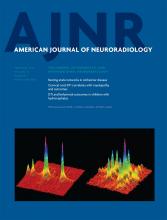Index by author
Machado, L.R.
- BrainYou have accessReduced Diffusion in Neurocysticercosis: Circumstances of Appearance and Possible Natural History ImplicationsG.T. Santos, C.C. Leite, L.R. Machado, A.M. McKinney and L.T. LucatoAmerican Journal of Neuroradiology February 2013, 34 (2) 310-316; DOI: https://doi.org/10.3174/ajnr.A3198
Magge, R.
- Extracranial VascularOpen AccessClinical Risk Factors and CT Imaging Features of Carotid Atherosclerotic Plaques as Predictors of New Incident Carotid Ischemic Stroke: A Retrospective Cohort StudyR. Magge, B.C. Lau, B.P. Soares, S. Fischette, S. Arora, E. Tong, S. Cheng and M. WintermarkAmerican Journal of Neuroradiology February 2013, 34 (2) 402-409; DOI: https://doi.org/10.3174/ajnr.A3228
Makoyeva, A.
- NeurointerventionYou have accessThrombosis Heralding Aneurysmal Rupture: An Exploration of Potential Mechanisms in a Novel Giant Swine Aneurysm ModelJ. Raymond, T.E. Darsaut, M. Kotowski, A. Makoyeva, G. Gevry, F. Berthelet and I. SalazkinAmerican Journal of Neuroradiology February 2013, 34 (2) 346-353; DOI: https://doi.org/10.3174/ajnr.A3407
Mallarini, G.
- Technical NoteYou have accessCarotid Artery Wall Thickness Measured Using CT: Inter- and Intraobserver Agreement AnalysisL. Saba, R. Sanfilippo, R. Montisci, J.S. Suri and G. MallariniAmerican Journal of Neuroradiology February 2013, 34 (2) E13-E18; DOI: https://doi.org/10.3174/ajnr.A2796
Mandell, D.M.
- BrainYou have accessIntracranial Atherosclerotic Plaque Enhancement in Patients with Ischemic StrokeM. Skarpathiotakis, D.M. Mandell, R.H. Swartz, G. Tomlinson and D.J. MikulisAmerican Journal of Neuroradiology February 2013, 34 (2) 299-304; DOI: https://doi.org/10.3174/ajnr.A3209
Mandelstam, S.A.
- PediatricsOpen AccessBilateral Posterior Periventricular Nodular Heterotopia: A Recognizable Cortical Malformation with a Spectrum of Associated Brain AbnormalitiesS.A. Mandelstam, R.J. Leventer, A. Sandow, G. McGillivray, M. van Kogelenberg, R. Guerrini, S. Robertson, S.F. Berkovic, G.D. Jackson and I.E. SchefferAmerican Journal of Neuroradiology February 2013, 34 (2) 432-438; DOI: https://doi.org/10.3174/ajnr.A3427
Mangano, F.T.
- Pediatric NeuroimagingOpen AccessDiffusion Tensor Imaging Properties and Neurobehavioral Outcomes in Children with HydrocephalusW. Yuan, R.C. McKinstry, J.S. Shimony, M. Altaye, S.K. Powell, J.M. Phillips, D.D. Limbrick, S.K. Holland, B.V. Jones, A. Rajagopal, S. Simpson, D. Mercer and F.T. ManganoAmerican Journal of Neuroradiology February 2013, 34 (2) 439-445; DOI: https://doi.org/10.3174/ajnr.A3218
Marotta, T.R.
- NeurointerventionYou have accessCanadian Experience with the Pipeline Embolization Device for Repair of Unruptured Intracranial AneurysmsC.J. O'Kelly, J. Spears, M. Chow, J. Wong, M. Boulton, A. Weill, R.A. Willinsky, M. Kelly and T.R. MarottaAmerican Journal of Neuroradiology February 2013, 34 (2) 381-387; DOI: https://doi.org/10.3174/ajnr.A3224
- EDITOR'S CHOICEExpedited PublicationYou have accessPipeline Embolization Device in Aneurysmal Subarachnoid HemorrhageJ.P. Cruz, C. O'Kelly, M. Kelly, J.H. Wong, W. Alshaya, A. Martin, J. Spears and T.R. MarottaAmerican Journal of Neuroradiology February 2013, 34 (2) 271-276; DOI: https://doi.org/10.3174/ajnr.A3380
The authors used the Pipeline device to treat 20 patients with acutely ruptured intracranial aneurysms. The most common types of aneurysms treated were blister and dysplastic/dissecting. Procedure-related morbidity/mortality overall was 15%, and 1 death directly related to the procedure occurred. Occlusion rates were 75% and 94% at 6 months and 12 months, respectively. The authors concluded that the Pipeline device offers a feasible treatment option in acute or subacute ruptured aneurysms, especially the blister type. Ruptured giant aneurysms remain challenging for both surgical and endovascular techniques; at this stage, the Pipeline device should be used with caution in this aneurysm subtype.
Martin, A.
- EDITOR'S CHOICEExpedited PublicationYou have accessPipeline Embolization Device in Aneurysmal Subarachnoid HemorrhageJ.P. Cruz, C. O'Kelly, M. Kelly, J.H. Wong, W. Alshaya, A. Martin, J. Spears and T.R. MarottaAmerican Journal of Neuroradiology February 2013, 34 (2) 271-276; DOI: https://doi.org/10.3174/ajnr.A3380
The authors used the Pipeline device to treat 20 patients with acutely ruptured intracranial aneurysms. The most common types of aneurysms treated were blister and dysplastic/dissecting. Procedure-related morbidity/mortality overall was 15%, and 1 death directly related to the procedure occurred. Occlusion rates were 75% and 94% at 6 months and 12 months, respectively. The authors concluded that the Pipeline device offers a feasible treatment option in acute or subacute ruptured aneurysms, especially the blister type. Ruptured giant aneurysms remain challenging for both surgical and endovascular techniques; at this stage, the Pipeline device should be used with caution in this aneurysm subtype.
Martin, N.A.
- NeurointerventionOpen AccessMiddle Cranial Fossa Sphenoidal Region Dural Arteriovenous Fistulas: Anatomic and Treatment ConsiderationsZ.-S. Shi, J. Ziegler, L. Feng, N.R. Gonzalez, S. Tateshima, R. Jahan, N.A. Martin, F. Viñuela and G.R. DuckwilerAmerican Journal of Neuroradiology February 2013, 34 (2) 373-380; DOI: https://doi.org/10.3174/ajnr.A3193








